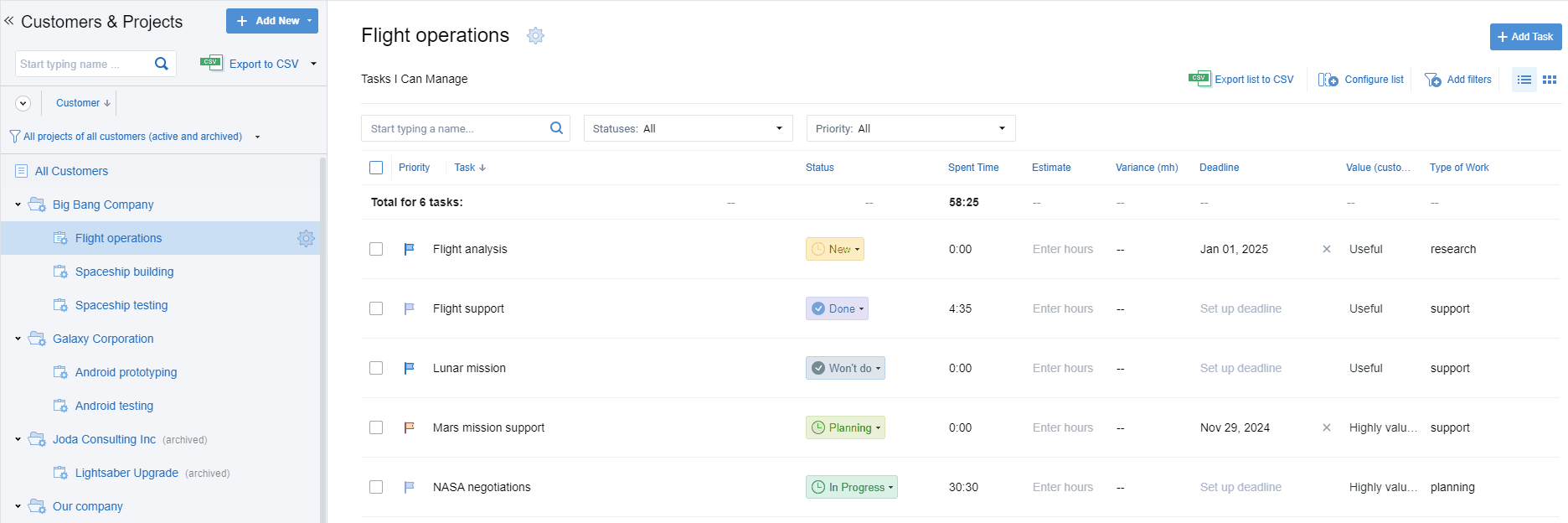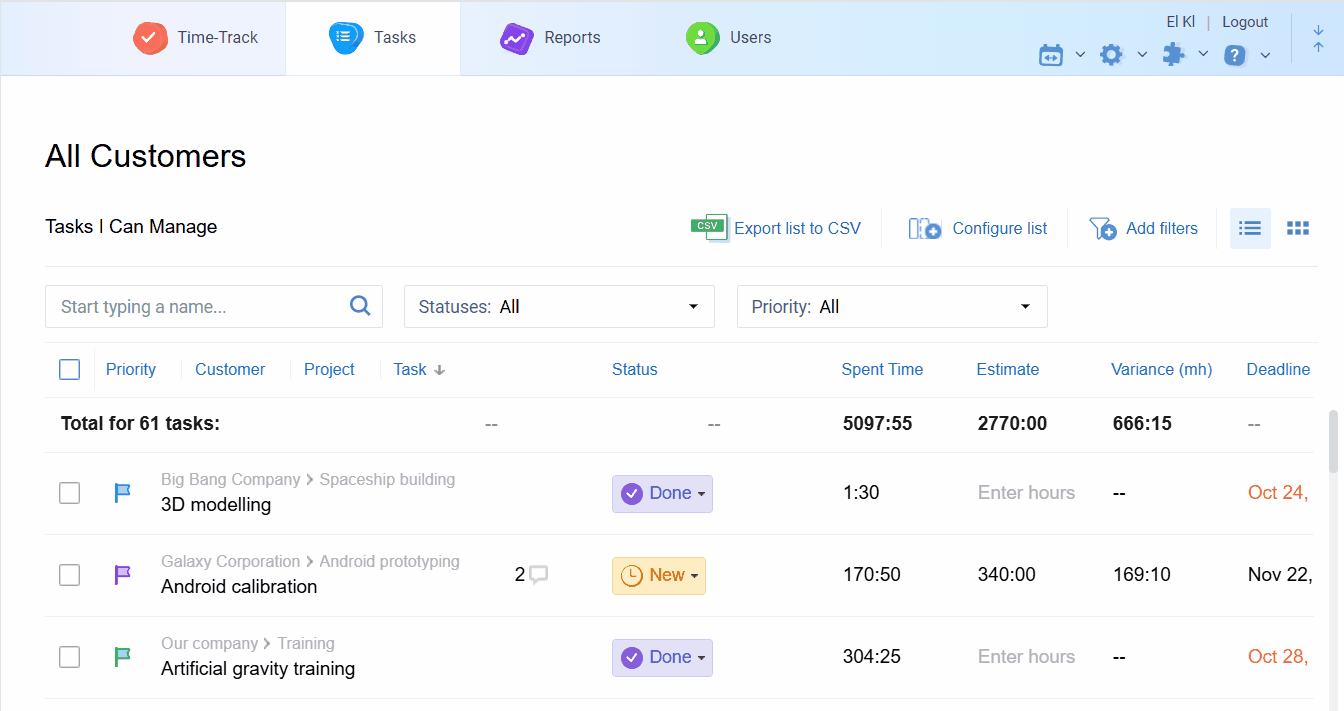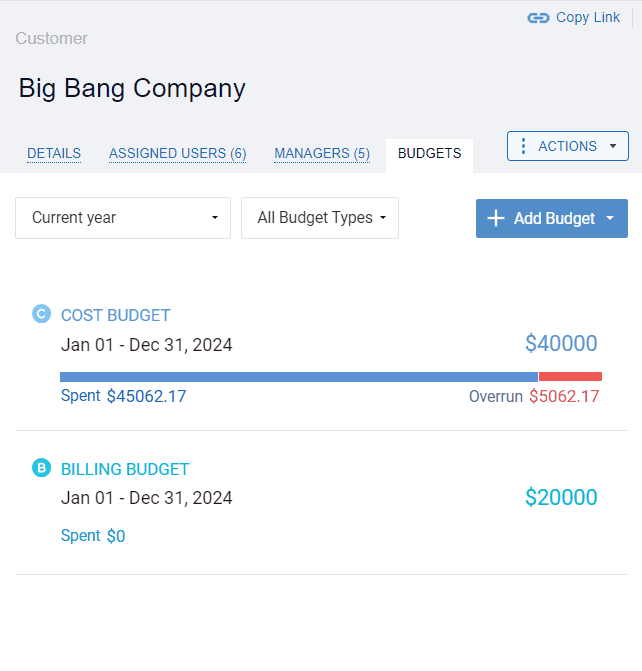
Agile project budgeting is like giving your project room to breathe and evolve as needed.
Unlike the traditional, static approach, agile budgeting allows for flexibility and adaptation. It’s perfect for projects that thrive on change and innovation. However, it’s not one-size-fits-all.
Let’s see if it’s right for your business and how to implement it well.
What Is Agile Project Budgeting?
Unlike traditional budgeting, which locks you into a fixed plan from the get-go, agile budgeting offers a refreshing twist on the conventional approach by embracing change and uncertainty, adapting as the project evolves.
Imagine setting sail on an adventurous journey, where you adjust your course based on weather conditions rather than sticking rigidly to a predefined path.
In a similar way, agile budgeting lets you allocate resources more flexibly, prioritizing tasks based on value and feedback received throughout the project management process. Thus, your project can remain responsive to shifting priorities and unforeseen challenges, ensuring that every dollar is wisely invested in achieving the desired outcomes.
Agile Project Budgeting Principles and Rules
In the realm of agile project management, the following principles equally apply to all your work processes, including budgeting:
- Value-driven approach: Focus on allocating funds where they’ll deliver the most value. Instead of being fixed, budgets should adapt and change based on what brings the best results. Think of it as prioritizing investments that promise the highest return in added value.
- Iterative financial reviews: Just like you break agile projects into sprints, you should make budgeting a recurring process. Regular check-ins allow you to reassess and reallocate resources based on project progress and changing priorities. This ensures funds are always directed where they are most needed.
- Transparency and collaboration: Open communication is key. Share financial insights with the entire team to foster a collaborative effort in managing resources. Transparency ensures everyone is on the same page, which helps in making informed decisions together.
- Flexibility with control: While the budget should be flexible to accommodate change, maintaining control is crucial to prevent overspending. Establish guidelines that allow for adjustments but also keep spending in check. It’s about balancing the ability to pivot quickly with financial discipline.
- Continuous improvement: Always be on the lookout for ways to improve budget processes. Gather insights from past projects, learn what worked, and refine your approach. This means being open to innovation, whether it’s adopting new tools or tweaking existing procedures to enhance efficiency.
- Customer-centric process: Align budget allocation with customer goals. This means always considering how financial decisions will impact the customer experience and end solutions. If the investment doesn’t serve the customer or project objectives, it might be time to reconsider its relevance.
Waterfall Approach vs. Agile Project Budgeting
When it comes to project budgeting, the waterfall approach and agile methodology are like night and day. However, they can both work out remarkably well depending on the situation.
In a nutshell, if your project operates best with clear guidelines and little deviation, waterfall might be your best bet. But if you thrive in an ever-changing environment and are willing to tweak your budget along the way, agile is the way to go.
Let’s break it down:
Waterfall project budgeting
Pros:
- Predictability: Waterfall is perfect for those who love a good plan. Once you’ve laid out your budget, it doesn’t change much. You’ll know exactly what you need to spend from the get-go, which means fewer surprises.
- Clarity: With a structured approach, every step has its own budget allocation. It’s as straightforward as following a recipe.
Cons:
- Inflexibility: If your project requirements change halfway through (because, let’s face it, they probably will), adjusting your budget is like trying to steer a cruise ship – slow and challenging.
- Overestimation: Because everything is planned up front, there’s a tendency to overestimate costs “just in case,” leading to potential budget bloat.
Best for:
- Construction projects with structured phases and clear timelines.
- Manufacturing businesses where processes are sequential, and changes can disrupt the entire production line.
Agile project budgeting
Pros:
- Adaptability: Agile is all about rolling with the punches. Your budget grows and shifts with the project, making it easy to reallocate funds as priorities change.
- Focus on value: You can channel resources toward areas that provide the most value, thanks to regular reassessment.
Cons:
- Uncertainty: If you’re a fan of stability, Agile might drive you a little bonkers. With budgets being frequently adjusted, it’s sometimes hard to see the overall financial picture.
- Scope creep: Without a solid, upfront budget, there’s a risk of adding more and more features, which can sneakily eat up resources.
Best for:
- Software development projects that require ongoing tweaks and improvements based on user feedback.
- Marketing projects where iterative testing and market feedback can guide campaign adjustments and enhance effectiveness.
How to Make Your Project Budgeting Agile
Step 1: Outline your overall scope of work
This step isn’t about creating a detailed map right away – think of it as sketching the big picture on a napkin. You want just enough structure to guide your project budgeting process:
- Brainstorm key deliverables: Start by jotting down the main deliverables and any major milestones you want to hit. Whether it’s launching a new product or completing a marketing campaign, have a clear aim in sight.
- Break it down: No need to tackle the entire project in one go. Segment it into smaller tasks or phases. This makes it all less daunting and more manageable. Plus, it’ll help you with prioritizing!
- Identify stakeholders: Who’ll be involved? Make a list of team members, partners, or departments that’ll be part of the action. The more the merrier, as long as everyone’s roles are clear.
- Assess the needs: Consider what tools, technology, and manpower you’ll need for each phase. Do you need additional software or marketing materials? Factor this in right from the start.
- Draft a timeline: Map out a basic timeline for your project. You’re not setting this in stone, but having a rough schedule can help keep things flowing seamlessly.
Pro tip:
Use actiTIME to organize your project scope, allocate work to employees, and share important task details with your team – this will set off your agile budgeting process.

Step 2: Break down your budget into smaller pieces
To make your budget more agile, we recommend estimating and allocating budgets at multiple levels – from greater project phases or milestones to more specific tasks and activities. By giving each task its own budget line, you will minimize surprises and be able to track expenses and adjust more effectively.
Pro tip:
actiTIME’s budget management functionality lets you allocate budgets to entire projects or customers, as well as the tiniest tasks. It allows you to slice and dice your overall budget to get smaller, more actionable, and super agile ones that will help you cruise through your entire project smoothly.

Step 3: Allocate budgets iteratively
This is where things get dynamic and flexible – it’s the backbone of agile budgeting!
- Plan out the process into sprints: Instead of planning your budget for the entire project upfront, divide your project into smaller, more manageable sprints or cycles. Think of these as mini-projects within your main project. By defining the scope and goals for each sprint, you can allocate funds as necessary, adapting as you go.
- Prioritize your tasks: Agile is all about prioritizing what’s most important. Identify high-priority tasks for each sprint and allocate your budget accordingly. This ensures that crucial elements get the financial attention they deserve right when they need it.
Pro tip:
actiTIME makes it easy to set priorities, deadlines, and estimates for tasks. Besides, it allows you to create custom work structures so you can easily organize work by entire projects or smaller sprints and track their progress using a variety of tools, including the Kanban board.

Step 4: Engage your team
Agile means collaboration. Thus, it’s pivotal to foster an environment where everyone feels comfortable to speak up:
- Encourage employees’ questions and suggestions: Since each team member brings their unique expertise, tapping into their knowledge can uncover hidden efficiencies or potential roadblocks.
- Use agile techniques to collectively estimate projects: Planning Poker, T-shirt sizing, and similar estimation methods not only make budgeting a team exercise but can also bring a bit of fun and gamification into the process.
- Give your team some skin in the game: Assign budget leaders for different project components to boost accountability and ensure that everyone is equally invested in managing expenses wisely.
Pro tip:
actiTIME offers a variety of user permissions that allow for different levels of access to project data and software functionality.
For instance, you can permit key employees to allocate budgets to projects and view other important financial data in order to engage them in the budgeting process and make it more collaborative.
Step 5: Cover multiple dimensions
Being agile means looking beyond just costs. Yes, expense budgeting matters, but so do time and client’s billing expectations:
- Time budgets help you keep those work hours under control, which is important for staying efficient and adaptable to change.
- Billing budgets allow you to make sure you don’t exceed the amount of money your clients have agreed to pay for the project, which is key to preserving their trust and your reputation.
Pro tip:
actiTIME lets you manage all three types of budgets – for costs, time, and billable amounts. All of them can be allocated to entire customers or projects, as well as smaller tasks.

Step 6: Monitor your progress continuously
Monitoring your progress continuously is key to making sure your project doesn’t drift into the dangerous waters of overspending or falling short of goals.
- Set up regular check-ins: Establish a rhythm for checking in on your project’s financial health. It could be weekly, bi-weekly, or monthly – whatever works best for your team. The idea is to create a routine that’ll keep everyone accountable and in the loop without feeling like it’s a financial inquisition.
- Utilize real-time tools: Embrace technology, and make it your ally. There are tons of real-time budgeting tools out there that can provide up-to-the-minute data on your expenses. This means no more waiting for end-of-month reports to know if you’re sinking or swimming.
- After each sprint, analyze your spending in greater depth: Did you stay within budget? Did unexpected costs pop up? Use these reflections to adjust your upcoming budgets. Flexibility is key – so pivot, adjust, and reallocate funds based on what you learn.
Pro tip:
Each budget you create in actiTIME is equipped with a visual progress bar that provides an overall picture of how you utilize resources, breaks data by days, and highlights budget overruns in red.
On top of that, actiTIME offers a plethora of other progress tracking features, including weekly timesheets, visual estimate trackers, a Kanban board, real-time reporting widgets, and more.

Step 7: Focus on value delivery
This step is all about ensuring that every dollar spent is maximizing value for your project. Here’s how you can implement it:
- Analyze your budgeting data: Look for patterns and trends. Are there areas where you’re spending more than expected? Maybe there’s a chunk of your budget going to that one feature that seemed cool but isn’t exactly a priority. Identify these sneaky costs and reel them in.
- Track your time like a hawk: Are your employees spending too much time on tasks that don’t align with your core project goals? It’s time to refocus and allocate hours to tasks that bring real value.
Pro tip:
actiTIME provides a wealth of project performance data you can tap into in order to sharpen your resource management strategies and create maximum impact with every decision. You can analyze the use of time, check on staff-related costs, and analyze them in comparison to hourly revenues to see which projects are most beneficial for your business.

Conclusion
An agile approach to project budgeting helps to streamline your financial planning and promotes flexibility in ever-evolving project landscapes. By embracing this methodology, you can respond more effectively to changes and deliver greater value to clients.
If you’re ready to take your budgeting process to the next level, consider giving actiTIME a try. It’s all you need to stay in control of your resources – be that time, costs, or billable hours.
Dive into the world of agile project budgeting with actiTIME today!












































